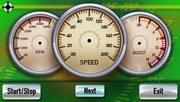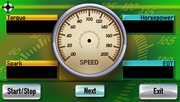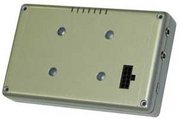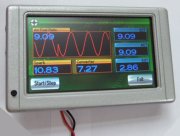Device Profile: Drew Tech DashDAQ car engine computer
Nov 8, 2006 — by LinuxDevices Staff — from the LinuxDevices Archive — 21 views A Linux-based, dashboard-mounted data acquisition (DAQ) device was named “Best New International Product” at the SEMA (Specialty Equipment Market Association) tradeshow this week in Las Vegas. Drew Tech's “DashDAQ” interfaces via ODB2, displaying a rich variety of engine diagnostics information.
A Linux-based, dashboard-mounted data acquisition (DAQ) device was named “Best New International Product” at the SEMA (Specialty Equipment Market Association) tradeshow this week in Las Vegas. Drew Tech's “DashDAQ” interfaces via ODB2, displaying a rich variety of engine diagnostics information.
(Click for larger view of DashDAQ)
  DashDAQ (Click to enlarge) |
The DashDAQ taps into the computer bus that connects the myriad sensors in modern automobiles with the ECU (engine control unit). It can read data, for example left and right wheel speeds, engine RPMs, oxygen levels in exhaust, the status of the gas caps or doors, spark plug timing, oil temperature, and on and on and on.
Drew Tech Engineer Dan DeMaggio explains, “There are lots of parameters you can read off the bus and put onto a guage. A lot of people are finding out that they don't have to hook a car up to physical sensors, in order to say, measure the power output. They just ask the engine. With a few extra sensors, you can even calculate a horsepower estimate.”
The DashDAQ can also send messages on the bus, for example to clear trouble codes. DeMaggio notes, “Garages charge their minimum labor rate of $75 or more to clear a trouble code, and that's only one message on the bus.”
Drew Tech says the DashDAQ is the first dashboard-mounted automotive DAQ to include a full color LCD display, rather than a monochrome display with color backlighting. The 4-inch touchscreen display has a resolution of 480 x 272, 320 nits brightness, a contrast ratio of 350:1, and an adjustable backlight, the company says.
Drew Tech is still finalizing which types of bus to support, but the DashDAQ will probably support CAN (controller area network) — mandated for use in all U.S. vehicles by 2008 — as well as the older ISO9141 bus standard.
What's under the, er, hood?
The DashDAQ is based on a 200MHz ARM processor running a 2.4-series Linux kernel, and fitted with 64MB of RAM memory, according to Drew Tech. An SD/MMC card slot supports removable flash devices of up to 8GB capacity.
Standard computing I/O includes USB 2.0 device and host ports, and a variety of optional wireless interfaces, including Bluetooth, 802.11b/g, and cellular modems. A serial bus expansion architecture enables the addition of other peripherals, the company says.
 OBD2 port (Click to enlarge) |
 Air-fuel graphing (Click to enlarge) |
The DashDAQ's OBD-II (on-board diagnostics) port supports ISO9141/KWP2000, as well as CAN / ISO15765, the company says, enabling the device to “capture, view, and record” information from cars sold by most major brands. Supported brands are listed here (large PDF download).
The DashDAQ additionally offers two analog inputs, which are said to support up to two wideband oxygen sensors, as well as accelerometers and other vehicle sensors from EGT (Exhaust Gas Technologies) and others. The inputs accept voltages from 0-5V, with a claimed accuracy of 97 percent.
DashDAQ software
On the software side, the DashDAQ is based on a 2.4.17-rmk2-lineo5 kernel, which was developed by Sharp to support its LH7A400 processor. DeMaggio said, “We chose the Sharp processor initially over OMAP because at that time, Sharp had paid Lineo to port Linux to its chip, and TI got a 'deer-in-the-headlights' look when we asked about Linux support. But things have really changed since then.”
Drew Tech previously used the Sharp SoC to develop an interesting open engine diagnostics tool that runs Linux.
DeMaggio continues, “If we switch chips, we'll jump to the mainline kernel. We're looking at Atmel chips. They have been very pro-active at getting stuff into mainline, instead of just putting out a one-time patch.”
The DashDAQ's graphics system is based on SDL (simple direct library) running on a Linux kernel framebuffer. It uses glibc, along with busybox. The internal flash memory uses CramFS, while the SD/MMC card can be formated with FAT or ext2, DeMaggio said.
Wind River's CMO, John Bruggeman, recently predicted a renaissance of Linux-based automotive applications. Asked for his perspective, DeMaggio replied, “We just see Linux as being a really easy way to do embedded. There's no particular advantage in automotive, but its reliable. And as a small company, it gives us the ability to change things.”
Availability
Drew Tech plans to ship the DashDAQ in Q1, 2007, as a direct-sales retail product with a basic set of gauges, priced at $600.
Additionally, the device is available with Linux development tools, for third parties wishing to develop applications for it. DeMaggio said, “We'll give you all the tools. It's just Linux. We'll provide the base software and the API for getting onto the vehicle bus.”
Suggested applications include automotive performance calculators, virtual gauges, custom GPS products, fleet monitoring, and portable video players.
This article was originally published on LinuxDevices.com and has been donated to the open source community by QuinStreet Inc. Please visit LinuxToday.com for up-to-date news and articles about Linux and open source.